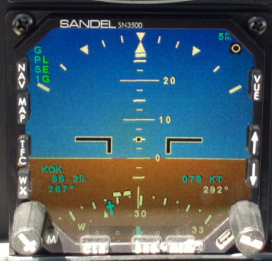Jacko wrote:
I don’t think there’s much point in having a heated AOA/LRI probe without full airframe de-icing. The reason being that airframe ice changes lift reserve, in which case whether the probe is iced or not, it will give false information.
Unless I’ve completely misunderstood how AOA indicators work (and that’s very possible), I don’t get what you’re saying. A situation where you’re iced up and your airplane (say on autopilot) has a high AOA to maintain altitude is potentially a good application of such indicators.
Also there seems to be some evidence (I’ve had it myself) that pitot tubes start to ice up above 0C and also can ice up below 0C in what most would call VMC. I have seen indication losses of ~5kt in such conditions, which go away when pitot heat is turned on. Hence heated pitots are common on aircraft even on types not normally used for IFR.
My concern is that since most of the AoA indicators for light GA have just a couple of holes at which they measure the (differential) air pressure, they will be just as liable to icing up. We have had many threads on that here, including one on one of the leading products whose heater was so powerful that if you left it on when on the ground it would probably damage the surrounding paint. So an installation would IMHO need an (unapproved) temperature switch right next to it…
The reason I did not install it was because I could not get any replies from anybody making them that it would work at high altitude, which was my main area of interest.
Why doesn’t the pitot heat have an auto setting? It shouldn’t be manual in 2015…
@denopa, you’re right, except that ice doesn’t just add weight to the airframe, it also lowers the stall AOA of an airfoil – so that the “safe” angle of attack which you established during the LRI/AOA instrument calibration procedure no longer provides the same margin of safety.
@Peter, by high altitude, do you mean for optimising approach and climb-out air speeds at altiports like Megève? I think it could be used for that, although in practice the French altiport runways are all plenty long/steep enough not to worry the likes of your machine.
Peter
The FAA and US industry is all wild about AoA sensors. Garmin, Aspen, Honeywell, AoA and others all have sophisticated AOA systems. The new Icon amphibian Light Sport has one prominently located top center of the panel. I have an early AoA sensor and it is a great tool for short field landings or emergency turns and I highly recommend one. The more sophisticated systems include a deice heater.
by high altitude, do you mean for optimising approach and climb-out air speeds at altiports like Megève? I think it could be used for that, although in practice the French altiport runways are all plenty long/steep enough not to worry the likes of your machine.
I was after the best way to reach the operating ceiling.
Currently I use the constant-EGT method to set the power (described here and elsewhere) but one has to have a guess at the airspeed and thus the AoA. Now, when near the top, I tend to use the Sandel EHSI in the AI mode to show the pitch, and I know that at 10 degrees it’s time to capitulate 

I’m looking forward to seeing the first in-depth reviews of Aspen’s “fake” AoA. A much simpler setup and no icing problem although with the same issue of not dealing with airfoil changes due to icing. I’m especially interested in how the Aspen software calibration works. It only has one flap setting.
Peter wrote:
Now, when near the top, I tend to use the Sandel EHSI in the AI mode to show the pitch, and I know that at 10 degrees it’s time to capitulate
More shows that you have the wrong aircraft for your mission profile 
Peter wrote:
One thing I realised when looking at them is that you have to get the optional heated version, otherwise it will be as useful as an unheated pitot tube (useless for N Europe, basically).
I’m still unsure of the practical usefulness of this device, but what has icing got to do with it? If your airplane starts icing down, then the AOA sensor would not measure correct in any case.
If your airplane starts icing down, then the AOA sensor would not measure correct in any case.
Yes, but I think the unheated AOA sensor will ice up long before the airframe will do so significantly. That is the same with a pitot tube. An unheated pitot is dangerous IMHO even on a “VFR-only” plane.